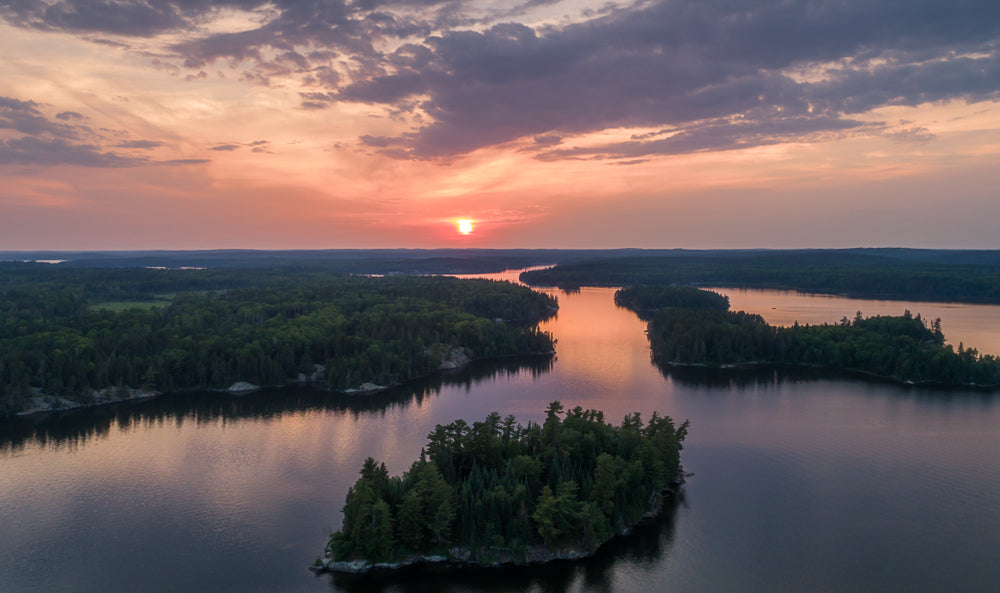Welcome to Turtle Island's vast and untamed boreal forest in the Great Lakes Region, an iconic landscape that stretches across the northern reaches of North America and beyond. In this expansive forest expanse, you'll find a breathtaking display of natural wonders, from towering evergreen trees to crystal-clear lakes and winding rivers. But it's not just a place of scenic beauty; the boreal forest is also deeply rooted in Anishinaabe cultural heritage.
A Geographic Marvel
The boreal forest, also known as the taiga, is a vast terrestrial biome that plays a critical role in regulating global climate patterns. Covering over 3.5 million square miles across Canada, Alaska, Russia and other northern countries, this expansive forest provides important ecosystem services such as storing carbon, purifying water and supporting biodiversity.
In Canada alone, the boreal forest covers almost 60% of the country's land area and is home to over 600 species of birds, including the iconic loon and bald eagle. From iconic Canadian animals such as moose, caribou, and wolves, bears and beavers, this ecosystem supports a rich web of life.
But it's not just about the plants and animals that call this forest home. The boreal forest has been inhabited by Indigenous peoples for thousands of years, who have developed a deep connection with the land and its resources. They have lived in harmony with nature, using traditional practices to sustain themselves and their communities..
A Cultural Connection
But beyond its natural wonders, the boreal forest holds great cultural significance for Turtle Island's Indigenous peoples. For thousands of years, these communities have lived in harmony with the land, using traditional practices to sustain themselves and their way of life.|
Today, many Indigenous communities continue to rely on the boreal forest for their way of life, including hunting, fishing, and gathering wild plants for food and medicine. The forest also holds cultural and spiritual significance, with many traditional stories, ceremonies, and teachings revolving around its plants and animals.
The boreal forest is not just a source of food and resources for Indigenous peoples; it's also deeply intertwined with their cultural beliefs and traditions. Many stories, ceremonies and teachings revolve around the plants and animals found in this forest, highlighting the strong connection between land and people.
Threats to the Boreal Forest
Unfortunately, the boreal forest is facing threats from resource extraction, development, and climate change. Clear-cut logging, mining operations, and oil and gas exploration are all impacting this fragile ecosystem. It's important that we work together to protect this unique landscape for future generations and to ensure that the traditional practices and knowledge of Indigenous peoples are preservedDespite its immense value and significance, the boreal forest faces numerous threats. Resource extraction, development, and climate change are all taking their toll on this fragile ecosystem. Deforestation from clear-cut logging, mining operations, and oil and gas exploration pose a serious risk to the health of the forest and its inhabitants.
The Sustainable Practices of Herbal Lodge
Within the boreal forest, there are many businesses and organizations that rely on its resources for their livelihood. One such company is Herbal Lodge, an Anishinaabe-owned business that specializes in harvesting traditional medicines from the land.
Herbal Lodge's products include Minagin, a natural pain relief product made from ingredients sustainably harvested from the boreal forest. The company's harvesting practices are deeply rooted in Anishinaabe cultural values and traditions, ensuring that the resources are gathered in a way that promotes sustainability and respects the land.
Through careful selection and harvesting of medicinal plants, Herbal Lodge not only provides valuable products to its customers but also plays a crucial role in preserving the biodiversity of the boreal forest. The company works closely with Indigenous harvesters to ensure that traditional practices are followed, and resources are not over-harvested.
A Partnership between Culture and Conservation
Herbal Lodge's relationship with the lands is a perfect example of the mutually beneficial relationship between culture and conservation. By relying on traditional knowledge and sustainable harvesting practices, the company contributes to the preservation and protection of the boreal forest. This, in turn, allows for the continued use of these resources by Indigenous communities for cultural and medicinal purposes.
The partnership between culture and conservation is essential in ensuring that the boreal forest remains a thriving ecosystem while also respecting the cultural significance it holds for Indigenous peoples. It is through collaborations like this that we can work towards a sustainable future for both the land and its people. By supporting businesses like Herbal Lodge, we are not only promoting the use of natural and traditional products but also actively contributing to the protection of the boreal forest and all that call it home. Let us continue to support biodiversity by respecting and preserving the cultural connections within this vast wilderness. So next time you use a product from Herbal Lodge, remember that you are not only benefiting from its natural healing properties but also playing a part in the preservation of a rich and diverse cultural heritage.
Protecting the Forest for Future Generations
It is up to all of us to protect and preserve this vast wilderness for future generations. By working together, we can ensure that traditional practices and knowledge are preserved, and the boreal forest remains a symbol of Turtle Islands untamed spirit.
So next time you find yourself in or near the boreal forest, take a moment to appreciate its beauty and significance. Listen to the rustling of leaves, the calls of birds, and the whispers of ancient wisdom carried on the wind. And remember, this majestic landscape is not just a source of wonder and inspiration but also an integral part of Turtle Islands cultural heritage.



